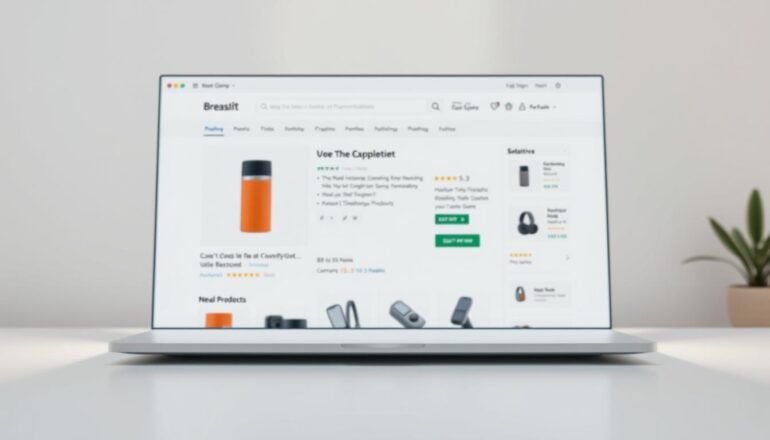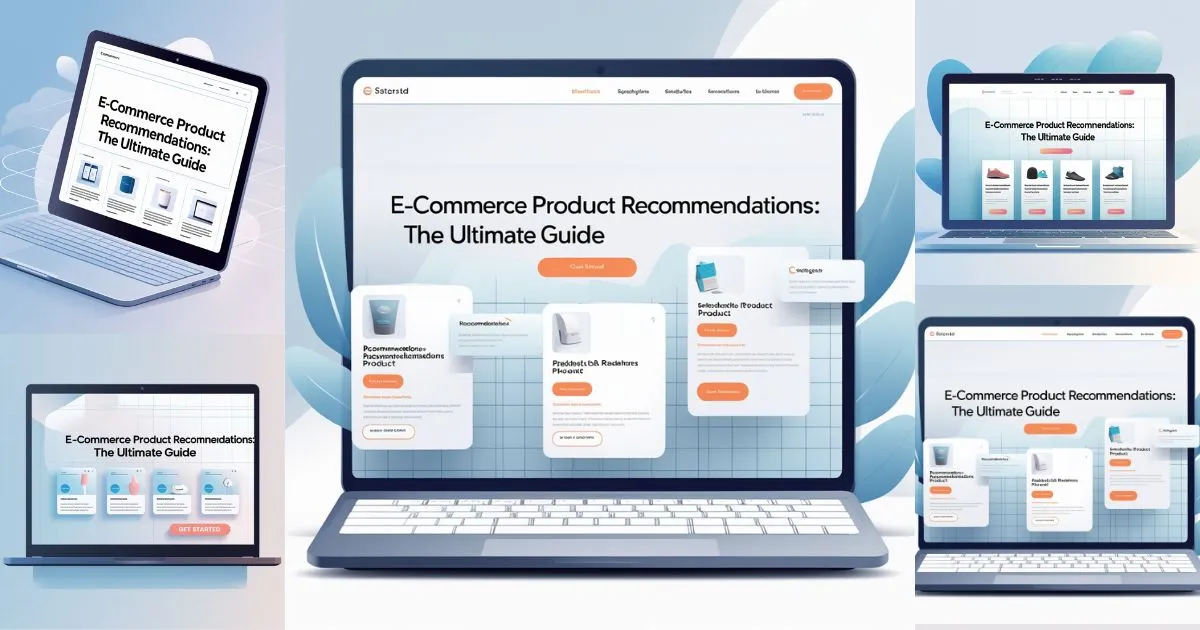As someone who loves watching the digital marketplace, I’ve seen how important e-commerce product recommendations are. They help make online shopping better by giving customers what they want. This makes them happy and keeps businesses ahead in the game.
Studies show that nearly 50% of people leave an online store if they don’t find what they need. But, over 90% like shopping where they feel seen and get suggestions that fit their tastes. This shows how key product recommendations are in making shopping online better and boosting sales.

In the world of e-commerce, the right product recommendations can be a game-changer. They help online stores make more money, keep customers happy, and stand out online. I’m excited to explore how these recommendations can change the game in online shopping.
Table of Contents
Key Takeaways
- E-commerce product recommendations can increase customer satisfaction and drive sales in online shopping.
- Personalized recommendations can enhance user experience and reduce bounce rates in the digital marketplace.
- Over 90% of customers prefer shopping with brands that recognize them and offer relevant suggestions in e-commerce product recommendations.
- E-commerce product recommendations can increase average order values by 10 to 30% in internet sales.
- Product recommendations can increase engagement time on a site and decrease bounce rates in the e-commerce product sector.
- Up to 35% of Amazon’s total sales are driven by product recommendations in the digital marketplace.
- E-commerce platforms that utilize recommendation engines can see an increase in conversion rates by 5 to 10% in online shopping.
Understanding the Power of E-Commerce Product Recommendations
In the digital world, making shopping easy is key for online stores to thrive. Product recommendations help a lot. They use algorithms and data to suggest items, which can be tailored to each customer. These suggestions are shared through many platforms and channels.
Product recommendations are vital for a great shopping experience. They help online stores understand what customers want. This way, they can suggest products that customers are likely to buy. For example, contextual recommendations are seen as more relevant and valuable, leading to more sales.
Some important stats show how crucial product recommendations are:
- 37% of shoppers who click on a product recommendation return to the site after their first visit.
- Consumers who interact with product recommendations are 4.5 times more likely to add items to their cart and complete a purchase.
- 52% of orders from customers who clicked on product recommendations include a recommended product.

In a virtual store, personalized recommendations make customers feel special. By using data and analytics, online stores can offer a unique shopping experience. This approach builds loyalty and boosts sales in the digital marketplace.
The Science of Customer Behavior in Online Shopping
Understanding customer experience is key in today’s online shopping world. With digital marketing, stores can learn a lot about consumer behavior. They can then shape their plans to fit the latest shopping trends. This way, they can offer experiences that boost sales and make customers happy.
What makes people shop online? It’s things like convenience, fun, and speed. Studies show that things like good availability, low prices, and easy returns are big draws. Free shipping and easy returns are also big pluses for shoppers.
By knowing these things, online stores can make their digital marketing better. For example, personalized advice can raise sales by 10% to 30%. And 61% of shoppers like it when stores get personal with them. This helps stores keep up with new shopping trends.

To succeed online, you need to get and use the latest consumer behavior and shopping trends insights. Focus on customer experience and use digital marketing well. This way, you can sell more, keep customers coming back, and stay on top in the market.
Essential Components of an E-Commerce Product Strategy
To make a good e-commerce product strategy, knowing the key parts is important. Data collection is a big part. It helps businesses learn what customers like and do. This info helps make personalized recommendations that customers might like more.
Customer segmentation is also key. It means grouping customers by their needs and actions. This way, businesses can give product recommendations that fit each group better. AI in e-commerce has changed how businesses make these recommendations. It helps them understand and predict what customers want.
- Defining target audience and their needs
- Conducting competitive analyses to identify market gaps
- Developing a unique value proposition
- Creating a pricing strategy that aligns with the target audience
By using these parts and ai in e-commerce, businesses can make a strong product strategy. This strategy can help sell more, make customers happier, and stand out from others. Good product recommendations and personalized recommendations are key. They help businesses connect with customers and offer products that really meet their needs.
Implementing AI-Powered Recommendation Systems
In the world of e-commerce, ai-powered shopping is key to better customer experiences. Machine learning helps online stores give personalized recommendations. This boosts sales and keeps customers coming back. McKinsey & Co found that 71% of shoppers want tailored interactions, and 76% get upset if they don’t get them.
Businesses can use content-based, collaborative, and behavior-based filtering for ai-powered recommendation systems. These methods look at lots of user data to suggest products. For example, Netflix makes $1 billion a year from AI-driven suggestions. AI also helps in cross-selling and upselling, which can increase revenue and make customers happier.
Some main advantages of AI-powered systems include:
- Improved user satisfaction
- Increased sales performance
- Enhanced customer engagement
- Personalized shopping experiences
By using AI-powered systems, online stores can beat the competition. They offer unique shopping experiences that boost sales and loyalty. With the right approach, businesses can fully benefit from AI recommendations and grow their e-commerce.
| Benefits | Description |
|---|---|
| Improved user satisfaction | AI-powered recommendations lead to increased user satisfaction, resulting in higher customer retention rates. |
| Increased sales performance | Personalized recommendations drive sales and revenue, with some studies showing an increase of over 10% in conversion rates. |
| Enhanced customer engagement | AI-powered recommendations improve customer engagement, leading to 50% more repeat purchases and increased customer loyalty. |
Personalization Techniques That Drive Sales
Exploring e-commerce innovations, I see that personalized shopping is key, not just a bonus. Ai algorithms help online stores offer tailored suggestions that meet each customer’s unique needs. McKinsey & Company found that 76% of shoppers prefer to buy from sites that personalize their experience.
So, why does personalization work so well? It lets businesses tailor their offers in real-time, based on what customers do and have done before. This strategy boosts sales, as seen with Helly Hansen, which saw a 100% jump in revenue per session after personalizing its approach.
Real-Time Personalization
Real-time personalization is a big deal in e-commerce, allowing businesses to act fast on customer actions. Ai algorithms help analyze data to offer personalized tips that lead to sales. Paint Your Life, for example, saw a 138% boost in leads thanks to personalized popups.
Behavioral Targeting
Behavioral targeting is another smart tactic, using what customers do to shape marketing efforts. By studying customer actions, businesses can craft campaigns that really work. Podbike, for instance, saw its conversion rates soar from 4.46% to 13.3% with targeted event invites.
Personalization offers many benefits, including:
- Higher customer happiness
- Better conversion rates
- A better shopping experience
By focusing on personalized shopping, businesses can outdo rivals and boost sales. Thanks to ai and e-commerce innovations, the future looks bright.
Best Practices for Cross-Selling and Upselling
As an online retailer, I know how key cross-selling and upselling strategies are. They help boost sales and raise the average order value. For example, Amazon sees up to 35% of its revenue from these tactics.
To succeed in cross-selling and upselling strategies, knowing your products well is crucial. Also, understanding what customers want is vital. This is where shopping cart optimization comes in. It helps by analyzing how customers behave and what they like. This way, online stores can see a 20% sales increase and build a loyal customer base.
Here are some examples of cross-selling and upselling strategies that worked well:
- Fanjoy boosted its average order value by 11.7% with personalized upselling and cross-selling.
- OLLY saw its subscription revenue jump by 63% thanks to in-cart subscription upsells.
- immi got a 5-10% boost in subscription opt-in rates with smart pop-up upsells.
By using these strategies, online stores can improve the shopping experience. They can also increase sales and achieve long-term success. It’s important to tailor cross-selling and upselling strategies to your customers’ needs. Always keep an eye on how well they’re working and make adjustments as needed.
| Company | Average Order Value Increase | Revenue Growth |
|---|---|---|
| Fanjoy | 11.7% | N/A |
| OLLY | N/A | 63% |
| immi | 24.55% | N/A |
Measuring the Success of Your Recommendation Engine
To see how well your recommendation engine works, you need to watch key numbers like click-through and conversion rates. These numbers help you find what to improve and make your conversion optimization better. For example, if lots of people click but don’t buy, your product suggestions might not match what they want.
Using data-driven marketing is key to knowing if your engine is doing its job. With real-time data, you can suggest products that fit what each person likes, making shopping better and selling more. Some interesting facts are:
- Personalized product recommendations can increase average order value (AOV) by 10% (Salesforce)
- 35% of purchases made on Amazon are attributed to product recommendations
- Recommendations on Netflix account for 75% of the content watched by users
Having a strong analytics tool helps you understand what customers like and want. This lets you make your recommendation engine better, leading to more sales and happy customers. A good recommendation engine can really boost how much people engage, stay loyal, and grow your sales.
Mobile-First Recommendation Strategies
Mobile commerce is on the rise, and focusing on mobile-first strategies is key. With 57% of users not recommending businesses with bad mobile sites, retailers must improve their mobile presence. This is crucial for boosting sales and keeping customers happy.
A mobile-first design can boost conversion rates by up to 40%. A one-second delay in mobile load times can cut mobile conversions by up to 20%. To ensure a smooth experience, retailers should design for mobile first. They should use simpler code and focus on accessibility.
Some important points for mobile-first strategies include:
- Optimizing for mobile-first indexing to improve search rankings
- Utilizing push notification strategies to engage customers on-the-go
- Designing app-specific recommendations to enhance the user experience
By focusing on mobile-first strategies, retailers can reach more customers on the move. With most internet traffic coming from mobiles, it’s vital to offer a seamless experience for mobile users.
By concentrating on mobile-first design and strategies, retailers can enhance their online marketplaces. This leads to a better user experience, driving sales and customer satisfaction.
| Mobile Commerce Statistics | Percentage |
|---|---|
| Mobile phone users worldwide | 5.27 billion |
| Global e-commerce sales attributed to mobile commerce | 67.2% |
| Expected rise of M-commerce by the end of 2021 | 72.9% |
Common Pitfalls and How to Avoid Them
E-commerce is growing fast, with the global market expected to hit $8 trillion by 2027. Online stores must watch out for common problems that can slow them down. One big issue is poor website optimization, which can cut down on sales. A slow website can lose 7% of customers, which is a big hit to sales.
To steer clear of these problems, it’s key to use recommendation algorithms to suggest products to customers. This means using data to understand what customers like. For example, knowing what makes customers happy or unhappy can help create better product suggestions.
Here are some important things to remember:
- Make sure your website works well on mobile, since more people start shopping on their phones.
- Use detailed size guides and 360-degree product videos to cut down on returns.
- Use recommendation algorithms to suggest products that customers might like.
- Invest in making your website faster and easier to use.
By avoiding common mistakes and focusing on e-commerce growth, online stores can offer a better shopping experience. This leads to more sales and happier customers.
Future Trends in E-Commerce Recommendations
Looking ahead, ai technology will be key in the e-commerce world. Consumers want more personalized and easy online shopping. It’s crucial to keep up with e-commerce trends to meet these needs.
About 27% of shoppers are excited about AI’s role in better deal comparisons and search results. This shows the value of ai technology in improving online shopping. Also, nearly 43% of users expect brands to use AI for a better shopping experience.
Some important e-commerce trends to watch include:
- Increased use of retail media networks, with revenue projected to account for 15.4% of all advertising revenue by 2028
- Growing demand for personalized interactions, with 67% of consumers desiring personalized interactions while shopping
- Rise of mobile commerce, with the share of mobile commerce in all e-commerce expected to reach 62% by 2027
By keeping up with these e-commerce trends and using ai technology and smart shopping experiences, online stores can offer personalized shopping. This approach can boost sales and keep customers happy, helping businesses stay competitive.
Scaling Your Recommendation System
To achieve e-commerce success, scaling your recommendation system is key. This means using data to improve your strategies and checking how well they work. Online stores can then reach more people and boost sales. Social commerce helps too, by using social media to promote products and talk to customers.
Scaling up involves using ai in retail. This means using machine learning to understand customer data and offer tailored suggestions. Some important stats to keep in mind include:
- Up to 15% increase in conversion rates through personalized product recommendations
- 35% of Amazon’s revenue is generated through product recommendation strategies
- 70% of consumers are more likely to make a purchase after engaging with recommended products
By using these strategies, you can boost e-commerce success and make customers happier. Always keep an eye on and tweak your system to keep it working well.
Using ai in retail also helps you understand your customers better. You can use their browsing history, past orders, and wishlist to suggest products. This way, you can make your system more effective at selling and making customers happy.
Scaling a recommendation system needs data analysis, ai in retail, and social commerce strategies. By combining these and always improving your system, you can grow your business and succeed in e-commerce.
| Strategy | Benefits |
|---|---|
| Personalized Product Recommendations | Up to 15% increase in conversion rates |
| Social Commerce | Increased customer engagement and interaction |
| AI in Retail | Improved customer insights and personalized experiences |
Conclusion: Transforming Your E-Commerce Business Through Smart Recommendations
E-commerce product recommendations are a game-changer for sales and customer happiness. They can transform your online store. By using the latest best e-commerce practices, like AI and mobile-first designs, you can see big improvements in sales optimization and conversion rates.
Personalized recommendations can really make a difference. They can boost average order value by 50% and cut cart abandonment by 15%. Also, 91% of shoppers prefer brands that offer tailored product suggestions. Smart recommendations make shopping more fun and keep customers coming back.
The future of e-commerce is bright, thanks to AI, machine learning, and predictive analytics. As you grow your recommendation system, use these new technologies to stay ahead. Success comes from always improving your strategies, analyzing data, and keeping up with online retail trends.
FAQ
What are product recommendations in e-commerce?
In e-commerce, product recommendations are personalized suggestions. They are based on what customers have looked at or bought. These suggestions aim to make shopping better and increase sales.
Why are product recommendations important for online stores?
For online stores, product recommendations are key. They boost customer happiness, sales, and help stay competitive online.
How does the psychology behind product suggestions work?
The psychology of product suggestions is about understanding what influences customers. This includes demographics, preferences, and what they’ve looked at. By knowing this, online stores can make recommendations that really speak to their customers.
What are the essential components of an e-commerce product strategy?
An e-commerce product strategy includes collecting data, segmenting customers, and using algorithms. Knowing these parts helps online stores make effective recommendations that please customers and boost sales.
What are the benefits and challenges of implementing AI-powered recommendation systems?
AI-powered systems offer personalized suggestions and better customer retention. But, they also face issues like data quality and biases. These challenges need to be tackled.
What personalization techniques can drive sales in e-commerce?
To drive sales, e-commerce uses real-time personalization, behavioral targeting, and context-aware suggestions. These methods help create shopping experiences that customers love.
How can cross-selling and upselling strategies be used with product recommendations?
Cross-selling and upselling can be used with product recommendations to increase sales. By suggesting related or more expensive items, online stores can make more money.
How can you measure the success of a recommendation engine?
To measure success, use key performance indicators and analytics tools. This helps online stores see what works and improve their strategies to boost sales.
What are the considerations for mobile-first recommendation strategies?
For mobile-first strategies, focus on user experience, app-specific suggestions, and push notifications. This helps reach customers on-the-go and increase sales.
What are some common pitfalls to avoid with product recommendations?
Avoid data quality and bias issues. Use data to spot and fix these problems. This ensures recommendations are effective and drive sales.
What are the future trends in e-commerce recommendations?
Future trends include new technologies, changing consumer habits, and better analytics. Staying on top of these trends helps online stores make effective recommendations that please customers and boost sales.
How can you scale a recommendation system effectively?
To scale a system, use data to improve and measure strategies. This approach helps reach more customers and increase sales.

